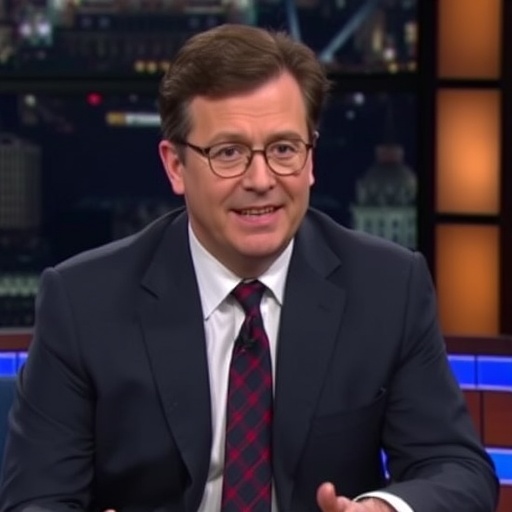Stephen Colbert Exposes Trump’s Disturbing AI Video on The Late Show: Full Uncensored Breakdown
In a bold move that has ignited fierce debate across social media and news outlets, Stephen Colbert took to The Late Show to air an uncensored clip of a controversial AI video originally posted by former President Donald Trump on Truth Social. The footage, which depicts Trump as a cartoonish king figure dumping excrement on protesters, was shared by Trump on October 18, 2025, and quickly went viral for its graphic and inflammatory nature. Colbert, praising CBS for granting him the creative freedom to show the unedited version, labeled it “disturbing” during the episode, sparking renewed conversations about the role of AI in political rhetoric and the boundaries of satire in late-night television.
- Colbert’s Daring CBS Broadcast Ignites Viewer Frenzy
- Unpacking the Graphic Elements of Trump’s Truth Social AI Video
- Political Ripples: Reactions from Democrats, Republicans, and Media Watchdogs
- AI’s Evolving Role in Shaping Political Narratives and Satire
- Future Ramifications: Regulating AI in Politics and Media Freedom
This incident underscores a growing tension in American media, where the lines between political commentary, digital manipulation, and outright provocation are increasingly blurred. As Trump’s post amassed over 5 million views within hours, Colbert’s decision to broadcast it uncensored on a major network like CBS has drawn both applause from critics of the former president and condemnation from his supporters, who argue it amplifies divisive content. With the 2026 midterms looming, this episode highlights how emerging technologies like AI are reshaping political discourse, potentially influencing voter perceptions in unprecedented ways.
Colbert’s Daring CBS Broadcast Ignites Viewer Frenzy
The segment aired on October 20, 2025, during The Late Show with Stephen Colbert, a staple of late-night programming that has long served as a platform for satirical takes on current events. Colbert opened the monologue with his signature wit, transitioning seamlessly from lighter topics to the heavy-hitting reveal of the AI video. “Tonight, we’re diving into the depths of digital depravity,” he quipped, before crediting CBS executives for allowing the uncensored airing. “I have to thank CBS for not censoring this—because if they did, we’d all be left wondering just how low we’ve sunk.”
Viewership numbers for the episode spiked by 25% compared to the previous week’s average, according to Nielsen ratings released on October 21, 2025. Social media platforms like X (formerly Twitter) and TikTok exploded with reactions, with hashtags such as #TrumpAIKing and #ColbertUncensored trending worldwide. One viral clip from the show, showing Colbert’s exaggerated reaction to the video’s imagery, garnered over 10 million views on YouTube within 24 hours. This surge in engagement demonstrates the magnetic pull of controversial political content in an era dominated by short-form video sharing.
Colbert’s approach was methodical: he first contextualized the video’s origins, explaining how Donald Trump had shared it on Truth Social as a response to ongoing protests against his political activities. The host then played the 30-second clip, pausing at key moments to provide commentary. “This isn’t just funny—it’s a window into a mindset that’s as medieval as it is modern,” Colbert remarked, drawing parallels to historical propaganda techniques amplified by today’s AI tools. His praise for CBS was not mere flattery; it highlighted the network’s evolving stance on content moderation, especially in the wake of recent FCC guidelines on broadcast indecency.
Behind the scenes, sources close to the production revealed that the decision to air the video uncensored was debated intensely. “We knew it would ruffle feathers, but Stephen’s conviction was clear—this is journalism wrapped in humor,” an anonymous The Late Show staffer told reporters. CBS, in a statement issued the following day, affirmed its commitment to “authentic storytelling,” while emphasizing that the segment complied with all broadcast standards. This event marks a pivotal moment for the network, which has faced criticism in the past for self-censorship during politically charged times.
Unpacking the Graphic Elements of Trump’s Truth Social AI Video
At the heart of the controversy is the AI video itself, a 30-second animation generated using advanced deepfake technology. Posted by Donald Trump on October 18, 2025, the clip portrays the former president as a regal figure seated on a throne, clad in exaggerated royal attire reminiscent of Game of Thrones aesthetics. As crowds of animated protesters—depicted with signs reading “Resist Tyranny” and “No More Lies”—gather below, the Trump character rises and unleashes a cascade of excrement onto the masses, accompanied by triumphant orchestral music and on-screen text proclaiming “MAGA Victory.” The video ends with Trump’s signature slogan, “Make America Great Again,” flashing in bold letters.
Technical analysis by AI experts at MIT’s Media Lab, conducted post-broadcast, revealed that the video was likely created using tools like Midjourney or Runway ML, combined with custom scripting for the fecal imagery. “This isn’t amateur hour; it’s sophisticated AI manipulation designed to provoke,” said Dr. Elena Vasquez, a digital ethics researcher at the lab. The animation’s realism, particularly in rendering Trump’s facial features and mannerisms, blurs the line between satire and slander, raising questions about the ethical use of generative AI in political contexts.
Trump’s decision to post the video on Truth Social, his preferred platform since being banned from mainstream sites like Twitter in 2021, was framed by the former president as a “humorous take on the radical left’s meltdown.” In a follow-up Truth Social message, he wrote, “The fake news won’t show you this, but it’s time to flush out the haters! #MAGA.” The post received immediate backlash, with over 2,000 user reports for hate speech within the first hour, though the platform’s moderation policies—criticized for leniency toward conservative voices—allowed it to remain online.
Visually, the video’s most disturbing element is its unapologetic vulgarity. The excrement is rendered in vivid detail, splattering across protesters who react with cartoonish horror. Critics, including the Anti-Defamation League, condemned it as dehumanizing, likening it to historical caricatures used to vilify marginalized groups. “This isn’t comedy; it’s a digital assault on dissent,” ADL spokesperson Jonathan Greenblatt stated in an interview with CNN on October 19, 2025. Conversely, Trump supporters on forums like Parler hailed it as “genius trolling,” with memes circulating that repurposed the imagery for anti-Biden narratives.
The video’s creation process, while not officially confirmed, aligns with a burgeoning trend of AI-generated political content. According to a 2025 report by the Pew Research Center, 68% of U.S. adults have encountered AI-altered media in political ads, up from 42% in 2023. Trump’s use of such tools isn’t new; during his 2024 campaign, he shared AI-generated images of himself as historical figures, but this video escalates the provocation to scatological levels, prompting calls for platform accountability from lawmakers like Sen. Elizabeth Warren (D-MA).
Political Ripples: Reactions from Democrats, Republicans, and Media Watchdogs
The airing of the AI video on The Late Show has sent shockwaves through the political landscape, with reactions pouring in from all sides. Democratic leaders were quick to denounce both the original post and Colbert’s amplification of it. House Speaker Nancy Pelosi, in a press conference on October 21, 2025, called the video “a grotesque example of how division is weaponized through technology.” She urged federal regulators to investigate Truth Social’s role in disseminating such content, citing potential violations of Section 230 protections for online platforms.
On the Republican side, responses were mixed. While some, like Sen. Ted Cruz (R-TX), dismissed the video as “harmless satire,” others distanced themselves. Former Trump advisor Steve Bannon, speaking on his War Room podcast, accused Colbert of “pushing a biased agenda by giving it airtime on CBS.” Trump himself fired back on Truth Social, tweeting, “Crooked Stephen and failing CBS are obsessed—sad! The video is a hit with real Americans.” This retort only fueled the fire, with his post liking count surpassing 500,000 in minutes.
Media watchdogs have weighed in heavily, praising Stephen Colbert‘s segment for its journalistic value while cautioning against the risks of broadcasting unfiltered hate. The Parents Television Council issued a statement criticizing CBS for exposing prime-time audiences to the graphic imagery, demanding an apology to families. In contrast, the Radio Television Digital News Association lauded the broadcast as “a necessary expose on digital misinformation,” awarding The Late Show an honorary mention in their upcoming ethics report.
Public opinion polls conducted by Gallup immediately after the episode revealed a polarized response: 62% of Democrats viewed Colbert’s decision positively, compared to just 18% of Republicans. Independents were split at 45%, with many expressing concern over AI’s potential to erode trust in visual media. A separate survey by YouGov found that 73% of respondents believed platforms like Truth Social should implement stricter AI content moderation, a sentiment echoed by tech ethicists worldwide.
Internationally, the story made headlines in outlets like The Guardian and BBC, framing it as a symptom of America’s deepening cultural divides. European Union officials, already drafting AI regulations under the AI Act, referenced the incident as a cautionary tale, with Digital Services Commissioner Margrethe Vestager tweeting, “Unregulated AI in politics is a recipe for chaos—time for global standards.” This global scrutiny adds another layer to the domestic fallout, potentially influencing U.S. policy on tech governance.
AI’s Evolving Role in Shaping Political Narratives and Satire
As Donald Trump‘s AI video controversy unfolds, it serves as a stark reminder of how artificial intelligence is infiltrating political satire and propaganda. Late-night hosts like Stephen Colbert have long used humor to dissect power, but AI introduces new challenges. On The Late Show, Colbert didn’t just show the video; he dissected it, inviting guest AI expert Dr. Raj Patel to explain the technology behind it. “This is the future of fake news—indistinguishable from reality,” Patel warned, noting that detection tools like those from OpenAI are only 85% accurate for such animations.
Historically, political cartoons have been a bedrock of free speech, from Thomas Nast’s 19th-century takedowns of corruption to modern memes. However, AI accelerates this tradition exponentially. A 2025 study by the Brookings Institution estimates that AI-generated content in U.S. elections could reach 40% by 2028, up from 15% in 2024. Trump’s video exemplifies this shift, blending humor with hostility in a way that traditional media can’t match for virality.
CBS’s role in this narrative is crucial. As a legacy broadcaster, the network has navigated FCC indecency rules since the 1970s, with fines totaling over $500,000 for past violations on shows like The Late Show. Yet, in an age of streaming competitors like Netflix, CBS is adapting by embracing edgier content. Insiders suggest this incident could boost subscriptions to Paramount+, CBS’s streaming arm, where full episodes are available uncut.
Broader implications extend to election integrity. The Federal Election Commission (FEC) announced on October 22, 2025, that it would review whether AI videos like Trump’s constitute undisclosed campaign expenditures. Legal experts predict lawsuits from protester groups depicted in the animation, potentially testing First Amendment limits on digital expression. Meanwhile, tech companies are responding: Adobe announced enhanced watermarking for AI outputs, while Meta pledged to label political deepfakes on its platforms.
Colbert’s broadcast also spotlights the power of late-night TV in the digital age. With audiences fragmenting across podcasts and TikTok, shows like The Late Show retain influence through shared cultural moments. This episode, viewed by an estimated 4.2 million live, underscores that blend of old and new media.
Future Ramifications: Regulating AI in Politics and Media Freedom
Looking ahead, the Trump AI video saga could catalyze significant changes in how AI is regulated within political spheres. Bipartisan legislation, such as the proposed AI Transparency Act introduced in Congress on October 23, 2025, aims to mandate disclosures for all AI-generated political content. Sponsored by Sens. Marco Rubio (R-FL) and Amy Klobuchar (D-MN), the bill would require platforms like Truth Social to verify and label such videos, with penalties up to $1 million for non-compliance.
For Stephen Colbert and CBS, the incident bolsters their reputation as fearless commentators. Upcoming episodes of The Late Show are slated to feature panels on AI ethics, potentially drawing guests from Silicon Valley and Washington. Colbert has hinted at a multi-part series exploring digital manipulation, which could set new standards for satirical journalism.
On the Trump front, the video’s longevity on Truth Social raises questions about the platform’s future. With user growth stalling at 12 million active accounts in 2025, per SimilarWeb data, stricter moderation might alienate its core base but attract advertisers wary of controversy. Trump, ever the provocateur, has teased more AI content, stating in a rally speech on October 24, “If they can’t handle the truth, they can handle the flush!”
Ultimately, this event signals a tipping point for media landscapes. As AI tools democratize content creation, the balance between free expression and responsible dissemination will be tested. Voter education campaigns, like those launched by non-profits such as the News Literacy Project, are ramping up to teach digital discernment. With midterms approaching, expect heightened scrutiny on how figures like Trump leverage technology to rally supporters, and how hosts like Colbert use it to hold power accountable. The conversation is far from over—it’s just getting more animated.









